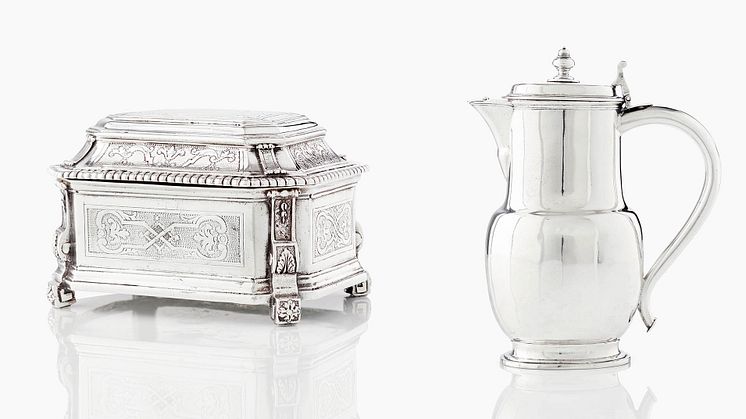
Press release -
Swedish silver donated to Nationalmuseum
Nationalmuseum has added two unique silver artefacts from 1715 to its collection. The acquisition of the pieces was made possible by a generous financial donation from Märta Christina and Magnus Vahlquist through the Friends of Nationalmuseum. The artefacts were latterly part of Lars Bellman’s silver collection, which was recently sold at auction.
The first of the two silver artefacts acquired by Nationalmuseum is a chocolate serving pot made in 1715 by Petter Henning in Stockholm. This was a new type of artefact, designed for hot chocolate. The first occurrence of the word choklad (‘chocolate’) in the Swedish language was in 1688. The drinking chocolate of the time would not be recognisable to us today, but was a viscous mixture containing chocolate, egg, milk, sugar, vanilla and various spices. As the mixture had to be stirred vigorously, chocolate pots had a hole in the lid so that a whisk could be inserted without the drink getting too cold. The newly acquired piece has a removable knob on the lid with a bayonet closure to cover the hole. It was commissioned by a member of the noble Oxenstierna af Eka och Lindö family. Drinking chocolate was believed to have medicinal properties, being good for the appetite and the mind and an excellent aphrodisiac.
From the same silversmith’s workshop is a jewellery box also dating from 1715. Although only 6½ centimetres in height, the design is monumental. The late baroque design, with oblique corners decorated with brackets, and the ornamentation, with well-rounded edges and embossed patterns, were very modern for their time. An embossed coat of arms inside the box reveals that it was commissioned by a member of the noble Lorichs family.
“These two pieces further enhance Nationalmuseum’s highly representative collection of Swedish silver. The chocolate serving pot is especially interesting from a design and cultural history perspective, having been made as far back as 1715,” said Micael Ernstell, curator of applied art at Nationalmuseum.
Nationalmuseum receives no state funds with which to acquire design, applied art and artwork; instead the collections are enriched through donations and gifts from private foundations and trusts. The acquisition has been made possible by a generous donation from Märta Christina and Magnus Vahlquist through the Friends of Nationalmuseum.
Inventory numbers
Petter Henning, Chocolate serving pot, 1715. NMK 53/2021.
Petter Henning’s widow, Jewellery box, 1715. NMK 54/2021.
Media enquiries
Micael Ernstell, curator, applied art, micael.ernstell@nationalmuseum.se, +46 8 5195 4392
Hanna Tottmar, head of press, press@nationalmuseum.se, +46 8 5195 4400
Categories
Nationalmuseum is Sweden’s museum of art and design. The collections include paintings, sculpture, drawings and graphic art from the 16th century up to the beginning of the 20th century and the collection of applied art and design up to the present day. The museum building was closed for renovation for five years and reopened in autumn 2018.

